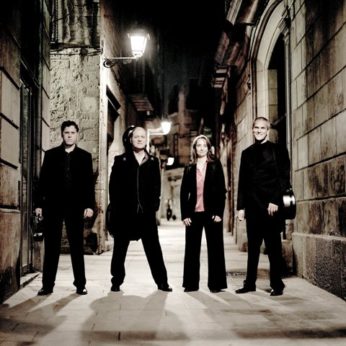Composer: Joseph Haydn (b. 1732 - d. 1809)
Performance date: 03/07/2013
Venue: St. Brendan’s Church
Composition Year: 1786-7
Duration: 00:57:15
Recording Engineer: Damian Chennells, RTÉ lyric fm
Instrumentation: 2vn, va, vc
Instrumentation Category:String Quartet
Artists:
Theo Dorgan -
[reader]
Cuarteto Casals (Abel Tomás Realp, Vera Martinez Mehner [violins], Jonathan Brown [viola], Arnau Tomás Realp [cello]) -
[quartet]

There will be readings of Michael Hartnett’s Mountains Fall on Us between the
movements
Haydn
himself described the birth of this extraordinary work in his preface to the
published score of the oratorio version. The commission he had received from
instrumental music on the Seven Last Words, to accompany the Good Friday
service as then celebrated by the Bishop of Cadiz in the Chapel of Santa Cueva,
a rock-cut chapel below the cathedral. It was first performed in the original
orchestral version on Good Friday 1787. It was well received from the start,
building on the old tradition of Passiontide devotions, and it became one of
Haydn’s most popular works during his lifetime. In order to facilitate wider
circulation, Haydn himself arranged the version for string quartet and
authorised a piano reduction. Later still, when he was writing his famous
oratorios – after hearing dramatic performances of Handel’s Messiah in
soloists and choir.
The
solemn introduction is followed by seven slow movements, each preceded by the
appropriate Latin quotation as recorded in the Gospels and a reading of the
relevant Gospel verses. In the original orchestral score, the Latin text is
written above the first violin’s part showing how the melody relates to the
words. The work concludes with a short presto movement that depicts the
earthquake that followed Christ’s death, the earthquake that is the herald of
the Resurrection.
The
uncompromising D minor introduction prepares us for what is to follow with
music of unrelenting darkness and savagery, though not without a handful of
phrases indicating the possibility of tenderness. The imagery is stark and
vivid even down to the blows of the hammer nailing Christ to the Cross. Of the
following seven movements, Haydn himself wrote to his English publisher: Each Sonata, or each setting of the text, is
expressed only by instrumental music, but in such a way that it creates the
most profound impression even on the most inexperienced listener.
Copyright © 2024 West Cork Music. All rights reserved.
Designed and developed by Matrix Internet